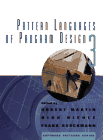Hybrid Vigor and Footprints in the Snow
The Introduction to Pattern Languages of Program Design 3
edited by Robert Martin, Dirk Riehle, and Frank Buschmann
Addison-Wesley Longman, 1998
 We hope, of course, that many of the people who
read, and use this language, will try to improve these
patterns -- will put their energy to work, in
the task of finding more true, more profound invariants -- and
we hope that gradually these more true patterns,
which are slowly discovered, as time goes on, will enter a
common language, which all of us can share."
Christopher Alexander et al. A Pattern Language, xv.
[Alexander et al. 1977]
We hope, of course, that many of the people who
read, and use this language, will try to improve these
patterns -- will put their energy to work, in
the task of finding more true, more profound invariants -- and
we hope that gradually these more true patterns,
which are slowly discovered, as time goes on, will enter a
common language, which all of us can share."
Christopher Alexander et al. A Pattern Language, xv.
[Alexander et al. 1977]
What’s new here is that there’s nothing new here.
Patterns are about what works. Patterns give us a way to talk about what works.
Stewart Brand, in his book How Buildings Learn, [Brand 1994] recounts
an oft-told (and perhaps
apocryphal)
tale of a brilliant, but lazy college planner
who built a new campus with no sidewalks at all. She waited for the first winter
and photographed where people made paths in the snow between the buildings. The
next spring, she put the pavement there. Patterns have this sort of quality.
Instead of making brash, premature, and probably erroneous conjectures about
what might work, pattern writers look for footprints in the snow,
and describe what has worked already.
Talking about what works seems so obvious. Why hasn’t this happened before?
Why is it happening now?


In the academic world, there is a relentless focus on the new.
Academics are
veritable
novelty vampires, who consume new ideas
rapaciously.
This phenomenon is particularly acute in computer science, where four-month old
technology can be deemed "traditional". Patterns, on the other hand, are dispatches
from the trenches about what works. They are about recurring solutions, and if
a lot of people have been doing something for a long time, it can’t be new, can it?
Because patterns are drawn from experience, they are not about invention or
creation per se. Pattern writers don’t play God, and create the universe in their
image, but they do play Adam and Eve, by choosing names for the denizens of their
garden. This is a responsibility that is not to be taken lightly.

Ralph Johnson
has pointed out that it is common in other academic disciplines
to study subject matter that the researchers did not themselves create.
Entomologists collect butterflies and categorize them, and talk about
these categories, and why they exist. However, biologists do not create
new forms of life (at least, not yet). Still, biologists can gather
specimens, make observations, and discover
categories without having
to worry about being accused of plagiarizing nature. Similarly, pattern
writers can play not only Adam and Eve, but
Carolus Linnaeus as well.
Computer science is a young discipline that has for too long seen itself
as a stepchild of mathematics and electrical engineering. While computer
scientists spent their first generation trying to behave like mathematicians
and physicists, they too often ignored the rich vein of
indigenous
subject matter that ran directly under their feet:
the experience that can be gleaned
from real programmers and real systems. It is a sign of new maturity and
self-reliance that we can now borrow from architecture, biology, literature,
communications, and, at last, even ourselves.

The patterns movement is in tune with a distintly '90s cultural
Zeitgeist.
It is a second-generation phenomenon, like Java. It’s about innovation
in an age of sampling. Sampling has become a way of life on the World Wide Web.
Popular musicians in the '90s often borrow shamelessly from their predecessors,
not by merely quoting their phrases, but by using digital
samplers
to directly
embed snippets of other people’s actual performances into their own work.
Their artistic predecessors had broken every rule of harmony and composition
as they strove unrelentingly for originality. Now, this exploration of
increasingly inhospitable new frontiers is over. Musicians in the '90s
solved their originality problem by ignoring it. Instead, they built on
the past by combining existing elements of their artistic heritage in new ways.
From the beginning, one of the things that has distinguished the patterns
community has been its aggressive disregard for originality. A good sign
that something new is happening is when people say that new music, poetry,
or art isn’t really music, poetry, or art at all.
People argue as to whether patterns are really computer science,
or even research. If what we are doing isn’t computer science, it ought to be.
While academia may be addicted to change, industry, on the
other hand, certainly has no problem with things that are tested
and proven. It does have a problem with talking about them.
Why indeed should people in industry give their architectural
insights away to their competitors? Why give away the store?
What is gained by paying people to write patterns instead of
programs? These are legitimate concerns. We certainly don’t
expect PLoP to become a trade secrets show-and-tell conference.

PLoP USA is held at
Allerton House, a turn-of-the-century manor surrounded by
statues and formal gardens, set on a wooded estate on the banks
of the Sangamon River, in rural Illinois. Pattern pilgrims travel
through forty miles of corn and soybeans to reach Robert Allerton’s
monument to architectural eccentricity. In making this journey,
through some of the richest farmland in the world, the term "hybrid vigor" somehow comes to mind.
PLoP draws people and patterns from what must seem, on the surface,
like an unworkably diverse pool. PLoP draws academics and practitioners,
managers and programmers, consultants and students, and even the odd
building contractor. Why the
smorgasbord? Why is the patterns
community so
eclectic? Maybe it’s because there really are
underlying architectural principles beneath seemingly disparate areas.
Maybe there really are good ideas that scale, generalize, and travel well.

Nature invented cross-pollination to propagate successful
innovations throughout a population rapidly. Farmers and
horticulturists later learned that they could manipulate
this process to create hybrids in order to counteract
inbreeding and enhance characteristics they found desirable.
The introduction of new genetic material from distant
relatives frequently produced exceptionally productive
and robust new varieties, hence the term "hybrid vigor".
Perhaps a caching scheme I heard about in a pattern culled from an application
that looks nothing like the ones I write will, when examined in the proper light,
be just what I need in one of my programs six months from now.
This potential for hybridization is one reason why industry
should be interested in patterns.
The cross-pollination among the unique cross-section of
industry and academia at PLoP allows best-practices to be
quickly and widely disseminated, thereby
bringing a healthy touch of hybrid vigor to all involved.
So patterns people can play not only Adam and Eve, and
Carolus Linnaeus, but
Luther Burbank as well.
Industry has more to gain than to fear from a real
engineering handbook for software architecture.
That which a culture glorifies will flourish. Unfortunately,
software architecture is often hidden. The patterns community
provides software architects with something they have never had before: an audience.

Software architecture is often an afterthought.
We reward results, even if they are the result of
slash-and-burn engineering, and result in sprawling,
shantytown architectures.
For too long, software architects have
toiled like the medieval artisans who
carefully carved the backs of their
gargoyles, knowing that high above the ground,
their artistry could be seen only by God.
Now that we have a forum where practitioners, and theorists, and programmers, and
professors can get together to laud that which has worked,
the architectural as well as aesthetic achievements of
heretofore anonymous software designers can start to
get some belated and well-deserved (mortal) recognition.
Languages, libraries, and frameworks are the medium in which software architecture
is ultimately expressed.
Patterns tell us how other architects have successfully put these pieces together.
By drawing attention to recurring problems, patterns can drive the evolution of
our tools, processes, languages, and frameworks,
so as to allow reusable artifacts to address these problems directly.
We can then use these off-the-shelf, and focus our design energy on ever loftier architectural
concerns.

A system might have a good architecture or a bad architecture, but it
can’t have no architecture at all.
Whether by encouraging the infrastructure for wide-scale reuse, or
the emergence of the components that underlie the latest rapid
prototyping environment, architecture is the key to the division
of labor that characterizes mature engineering disciplines.
Reuse is an act of trust.
The pioneer who blazes a trail knows if he or she turned left to
avoid a two hundred-mile detour, or to avoid a fallen branch. Those who
follow do not have the benefit of this insight. They know only that to
continue to follow the trail, they must turn left. Architecture needs
to be about ideas that can stand on their own. Designers need a
vocabulary that conveys meaning without requiring an encyclopedic,
white-box knowledge of each and every abstraction of everyone who uses it.

Thomas Malthus was a 19th century clergyman and economist who
grimly hypothesized that successful communities would grow until
their needs exceeded the resources available to sustain them.
Dr. Malthus came to Allerton Park in
1996. We received over 70
submissions,
and nearly 110 registrations.
Our infrastructure was bursting at the seams.
Our submissions were more eclectic than ever.
It seems inevitable that these forces will cleave our
diamond-in-the-rough along its natural fissures.
Indeed, these facets are already emerging.
EuroPLoP,
TelePLoP, ChiliPLoP, and UP, have joined good ol’
PLoP
Classic USA.
New books about patterns are sprouting like high-yield
hybrids in the hot summer sun. The success of patterns
has even turned them into a lightning rod for new academic research.

Powerful forces have been set into motion--have set us into motion.
It’s fascinating to contrast a design conversation today with one we
might have had a few years ago. For instance, not only are the once
abstruse
architectural notions presented in the
Gang of Four book
[Gamma et al. 1995]
common knowledge, but they can be proposed,
compared, and dismissed with one simple name. They are becoming
part of a design
lexicon
that may well be with us for generations.
The power and conciseness that this new vocabulary gives its speakers is striking.
We are still a long way from having the sort of pattern language for
software architecture that Alexander attempted for building.
Still,
three years ago, few of us really had any idea where all of this might be headed.
It’s hard now not to think that we are witnessing something important and enduring.
Just under a century ago, two brothers could build an airplane in a bicycle shop.
Just a generation later, the engineering expertise that went into a
pre-World War II warplane dwarfed any of the individuals engaged in its design.
The pioneers had been supplanted by teams of superbly skilled,
highly specialized collaborators who together defined the architectural
lexicon and division-of-labor that allowed them to partition their work
and integrate it into a working whole.
They were able to divide up their work because they could
discern the distinct, emerging architectural elements in
their engineering domain, and the boundaries between them.
Small groups of skilled designers can still juggle the pieces,
but these pieces are cast at a much higher level.

In many ways, software architecture is just leaving its bicycle shop era.
Brad Cox
[Cox 1995]
has observed, for instance, that "unlike the hardware industry,
which has organized itself into a fully elaborated rainforest of mutually
interdependent structures of production trees, the software
industry remains stuck in the unicellular, bacterial stage of the primordial ooze."
Today, interstate highways
run over the tracks left by
the wheels where westbound wagon trains once rolled.
The pioneers could never have conceived of the engineering
effort necessary to build the spectacular bridges and tunnels we have built,
nor of the machinery to move mountains of stone, concrete, and asphalt
that would dwarf the pyramids. We can make their journey of months in a matter of hours or days.
Yet, we did this not by blazing new trails of our own, but by
looking for footprints in the snow, and putting the
pavement there.
Brian Foote, Urbana, Illinois
[Alexander et al. 1977]
Christopher Alexander, Sara Ishikawa, and Murray Silverstein
A Pattern Language
Oxford University Press, Oxford, UK, 1977
[Brand 1994]
Stewart Brand
How Buildings Learn: What Happens After They're Built
Viking Press, New York, NY, 1994
[Cox 1995]
Brad Cox
No Silver Bullet Revisited
American Programmer Journal
November, 1995
[Gamma et al. 1995]
Eric Gamma, Richard Helm, Ralph Johnson, and John Vlissides
Design Patterns: Elements of Reusable Object-Oriented Software
Addison-Wesley Longman, Reading, MA, 1995
Brian Foote foote@cs.uiuc.edu
Last Modified: 23 April 2004
 We hope, of course, that many of the people who
read, and use this language, will try to improve these
patterns -- will put their energy to work, in
the task of finding more true, more profound invariants -- and
we hope that gradually these more true patterns,
which are slowly discovered, as time goes on, will enter a
common language, which all of us can share."
Christopher Alexander et al. A Pattern Language, xv.
[Alexander et al. 1977]
We hope, of course, that many of the people who
read, and use this language, will try to improve these
patterns -- will put their energy to work, in
the task of finding more true, more profound invariants -- and
we hope that gradually these more true patterns,
which are slowly discovered, as time goes on, will enter a
common language, which all of us can share."
Christopher Alexander et al. A Pattern Language, xv.
[Alexander et al. 1977]









